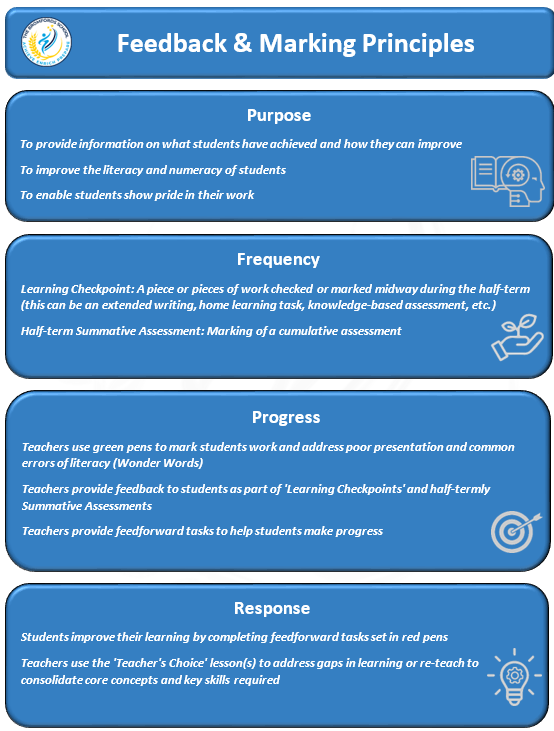Marking & Feedback
Feedback provides information to learners about their progress and how to improve (EEF).
Marking is a central part of a teacher’s role and can be integral to progress and attainment. Written responses offer a key way of providing feedback to pupils and helping teachers assess their students’ understanding.
Individual departments use the principles outlined to create their own subject-specific, tailored departmental assessment policies. Therefore making it fit the demands of subject curriculum, whilst still meeting the school principles. Subject leaders are responsible for setting and monitoring the quality and frequency of feedback from teachers working within their team.
The following definitions and principles apply to our principles of marking and feedback which are in line with the NEU Marking Policy checklist (Click here for checklist).
Feedback = providing more detailed guidance to the learner in order to help them to improve their knowledge, understanding and skills.
Marking = the routine activity of reading, checking, monitoring, (when appropriate) correcting, and (where appropriate) giving a mark to students’ written work.
|
Feedback |
Marking |
|
Formative |
Summative |
|
Assessment for Learning |
Assessment of Learning |
|
Moves Learning Forward |
Measures Learning |
|
Provokes Thinking |
Directs Thinking |
|
Suggests |
Solves |
|
“How could you…?” |
“You should….” |

Live Feedback
- Live feedback is instant feedback that is provided for students to act upon within the lesson, facilitating immediate improvement of skills & knowledge.
- Live feedback for students may take a variety of formats, including but not exhaustive of; verbal feedback from teacher; peer and self-assessment; whole class feedback; modelling & exemplars; use of rubrics etc
- The Bromfords lesson structure facilitates live feedback for students. Staff ensure that lesson planning allows suitable activities & time for students to act on live feedback provided.
- Typically, teachers should look to provide personalised feedback to 5 students each lesson, signified by the use of a green pen. This usually takes place whilst students are completing independent tasks. It is not be possible to provide personalised feedback to all students within a given lesson, but every effort is made to provide this to all across a series of lessons.
- It is expected to see evidence of students acting on live feedback in class books. Students must use red pen, whereby they are acting on in-class feedback.






